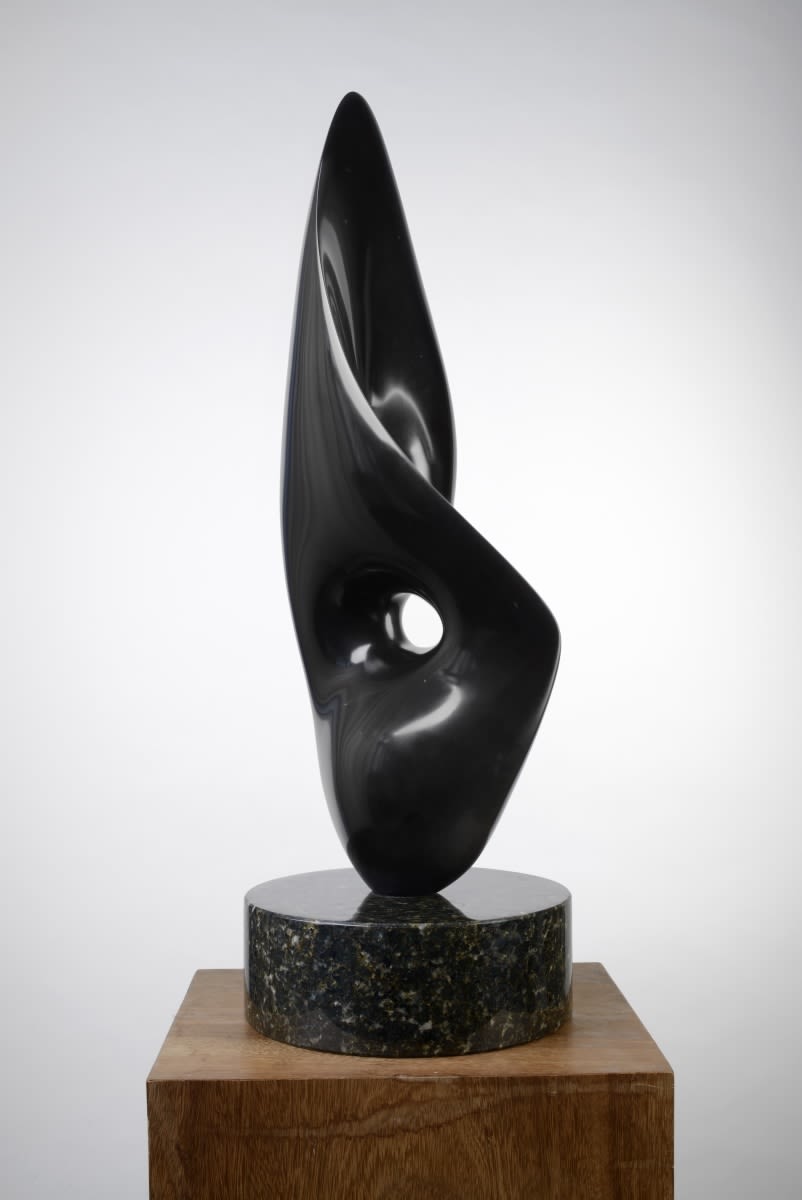Antoine Poncet
Gaillarde, 2011
Black marble from Belgium (pedestal in green granite)
27 x 9 7/8 x 9 7/8 in, 68.5 x 25 x 25 cm
Pedestal (4 x 10 5/8 in, 10 x 27 cm)
Pedestal (4 x 10 5/8 in, 10 x 27 cm)
Antoine Poncet, son of artist Marcelle Poncet and grandson of Symbolist painter Maurice Denis, spent his youth cleaning brushes in the studio before forging his own artistic identity as a...
Antoine Poncet, son of artist Marcelle Poncet and grandson of Symbolist painter Maurice Denis, spent his youth cleaning brushes in the studio before forging his own artistic identity as a sculptor under the instruction of Germaine Richier in Zurich and his godfather Casimir Reymond in Lausanne.
Establishing his studio in Paris in 1945, Poncet’s work was influenced by Ossip Zadkine’s classes at the Académie de la Grande Chaumière. However, it was his meeting with Jean Arp in 1951 that proved to be the most decisive stimulus upon the development of Poncet’s harmonious abstract forms. Arp convinced Poncet to abandon figurative representation in favour of the poetic essence of form. With this liberation from narrative, Arp praised his work saying, “Nothing is as close to nature as a sculpture by Poncet”.
‘Gaillarde’ encapsulates the fascinating dialectic in Poncet’s work between the animated living form and the void. Playing with the resonance of closed and open spaces, Poncet allows his porous sculptures to be articulated by gaping holes and relishes the suggestion of transitory fluid material. Poncet’s experimentation with the permeable form is greatly influenced by the mantra of his father Marcelle Poncet: “As in music never put two long measures side by side, and when we find two identical volumes assembled in a sculpture, a rupture is necessary”. Poncet’s creation of a division between the interior and exterior material by piercing the form invites the viewer to move beyond the objective world into an existential space. The alchemy of these tremulous forms alludes not only to Poncet’s interest in the natural world, but also to the spiritual depths of abstraction. Indeed Poncet argues that, “all is movement in nature, in life”.
Antoine Poncet was awarded the Federal Sculpture Prize, Switzerland in 1955, represented Switzerland at the Venice Biennale in 1956 and held his first solo exhibition in Paris at the Galerie Iris Clert in 1959. With acclaimed international exhibitions in Europe and the USA, Poncet was awarded the Henry Moore Prize in Japan in 1983. Poncet’s work can now be found in public collections around the world, including the Musée National d’Art Moderne, Paris; Galeria d’Arte Moderna, Milan; Museum of Modern Art, New York; Museum of Fine Art, Minneapolis; Art Institute of Chicago; and Open Air Museum, Hakone, Japan.
Establishing his studio in Paris in 1945, Poncet’s work was influenced by Ossip Zadkine’s classes at the Académie de la Grande Chaumière. However, it was his meeting with Jean Arp in 1951 that proved to be the most decisive stimulus upon the development of Poncet’s harmonious abstract forms. Arp convinced Poncet to abandon figurative representation in favour of the poetic essence of form. With this liberation from narrative, Arp praised his work saying, “Nothing is as close to nature as a sculpture by Poncet”.
‘Gaillarde’ encapsulates the fascinating dialectic in Poncet’s work between the animated living form and the void. Playing with the resonance of closed and open spaces, Poncet allows his porous sculptures to be articulated by gaping holes and relishes the suggestion of transitory fluid material. Poncet’s experimentation with the permeable form is greatly influenced by the mantra of his father Marcelle Poncet: “As in music never put two long measures side by side, and when we find two identical volumes assembled in a sculpture, a rupture is necessary”. Poncet’s creation of a division between the interior and exterior material by piercing the form invites the viewer to move beyond the objective world into an existential space. The alchemy of these tremulous forms alludes not only to Poncet’s interest in the natural world, but also to the spiritual depths of abstraction. Indeed Poncet argues that, “all is movement in nature, in life”.
Antoine Poncet was awarded the Federal Sculpture Prize, Switzerland in 1955, represented Switzerland at the Venice Biennale in 1956 and held his first solo exhibition in Paris at the Galerie Iris Clert in 1959. With acclaimed international exhibitions in Europe and the USA, Poncet was awarded the Henry Moore Prize in Japan in 1983. Poncet’s work can now be found in public collections around the world, including the Musée National d’Art Moderne, Paris; Galeria d’Arte Moderna, Milan; Museum of Modern Art, New York; Museum of Fine Art, Minneapolis; Art Institute of Chicago; and Open Air Museum, Hakone, Japan.
